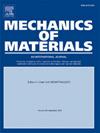Predicting multiple fatigue properties of twinning-induced plasticity steels by black-box and white-box machine learning
IF 3.4
3区 材料科学
Q2 MATERIALS SCIENCE, MULTIDISCIPLINARY
引用次数: 0
Abstract
Predicting multiple fatigue properties of metals under a wide range of conditions is still a challenge, as massive high-dimension inputs and multiple outputs are involved. We systematically conduct fatigue experiments on TWIP steel under various conditions, including different preloading methods, temperatures, strain amplitudes and mean strains. Using experimental data, we propose both black-box and white-box machine learning models to predict the fatigue performance of TWIP steel. The black-box model employs dimensionality reduction, clustering and regression techniques to achieve simultaneous predictions for fatigue life and maximum stress amplitude. The predicted fatigue lives are 100% within 3✕ error band and 88.31% within 2✕ error band. The predicted maximum stress amplitudes are all within 1.51✕ error band. The white-box model utilizes symbolic regression and matching analysis to automatically discover several predictive formulas for fatigue life and maximum stress amplitude, without any predefined equations. The three optimal fatigue life prediction formulas yield 100% predicted values within 3✕ error band and 98% within 2✕ error band. The two optimal maximum stress amplitude prediction formulas yield predicted values all within 1.09✕ error band. Based on the results, we discuss the applicability of our models and propose suggestions for future developments in machine learning fatigue performance predictions.
求助全文
约1分钟内获得全文
求助全文
来源期刊

Mechanics of Materials
工程技术-材料科学:综合
CiteScore
7.60
自引率
5.10%
发文量
243
审稿时长
46 days
期刊介绍:
Mechanics of Materials is a forum for original scientific research on the flow, fracture, and general constitutive behavior of geophysical, geotechnical and technological materials, with balanced coverage of advanced technological and natural materials, with balanced coverage of theoretical, experimental, and field investigations. Of special concern are macroscopic predictions based on microscopic models, identification of microscopic structures from limited overall macroscopic data, experimental and field results that lead to fundamental understanding of the behavior of materials, and coordinated experimental and analytical investigations that culminate in theories with predictive quality.
 求助内容:
求助内容: 应助结果提醒方式:
应助结果提醒方式:


